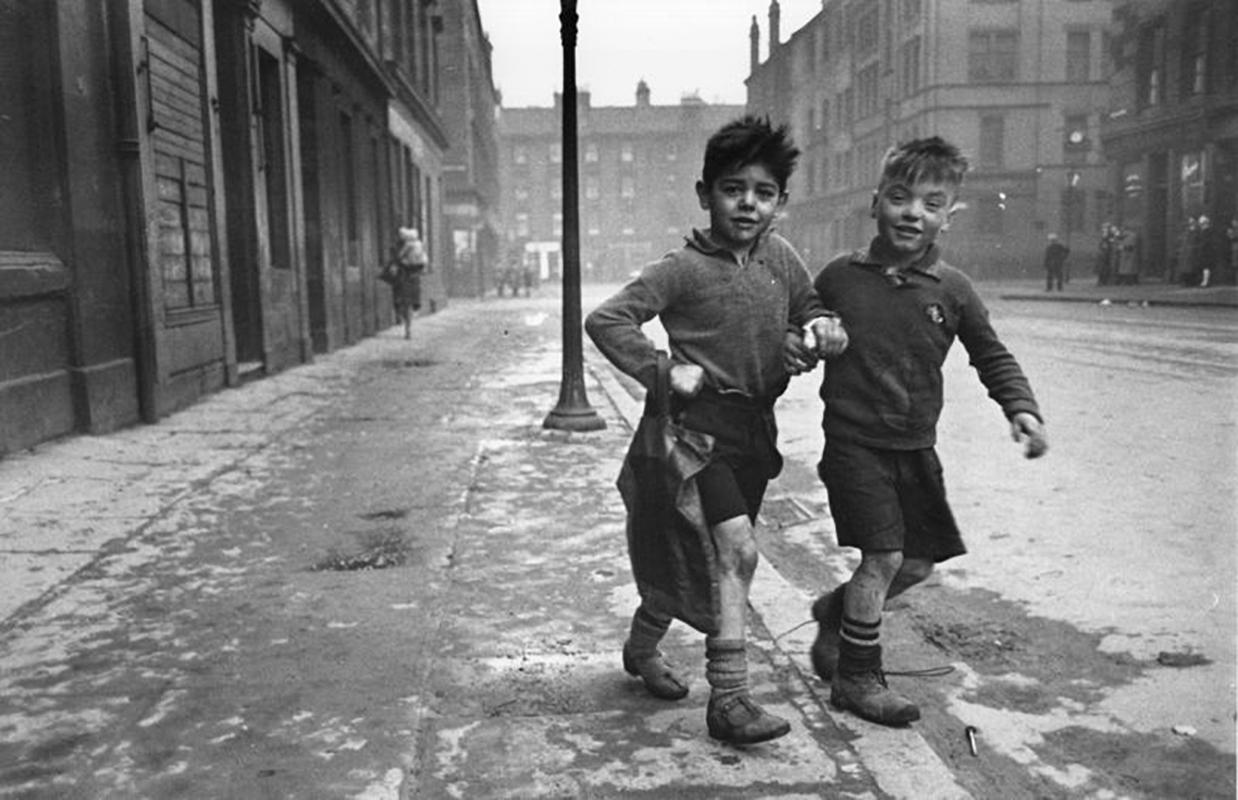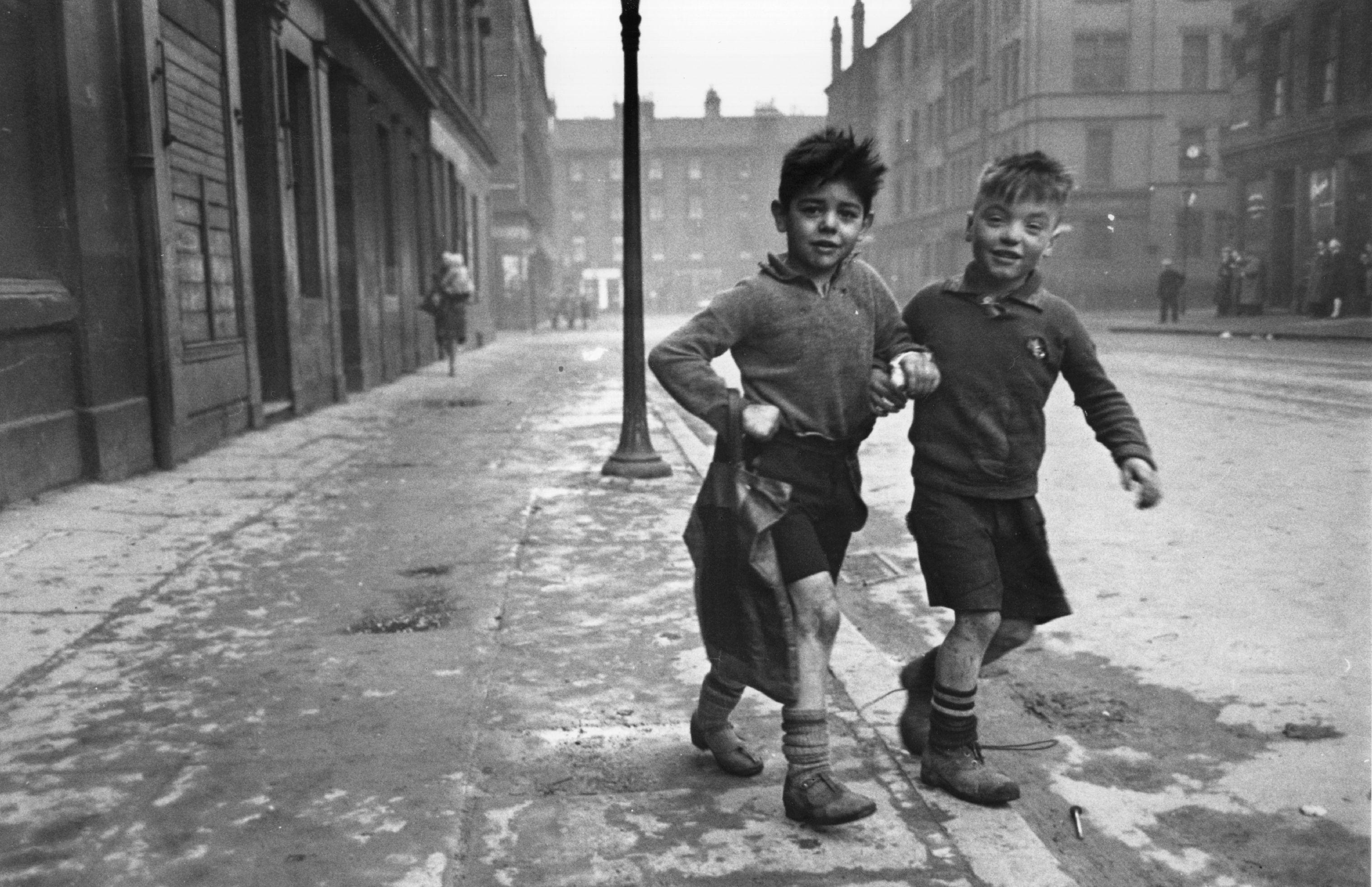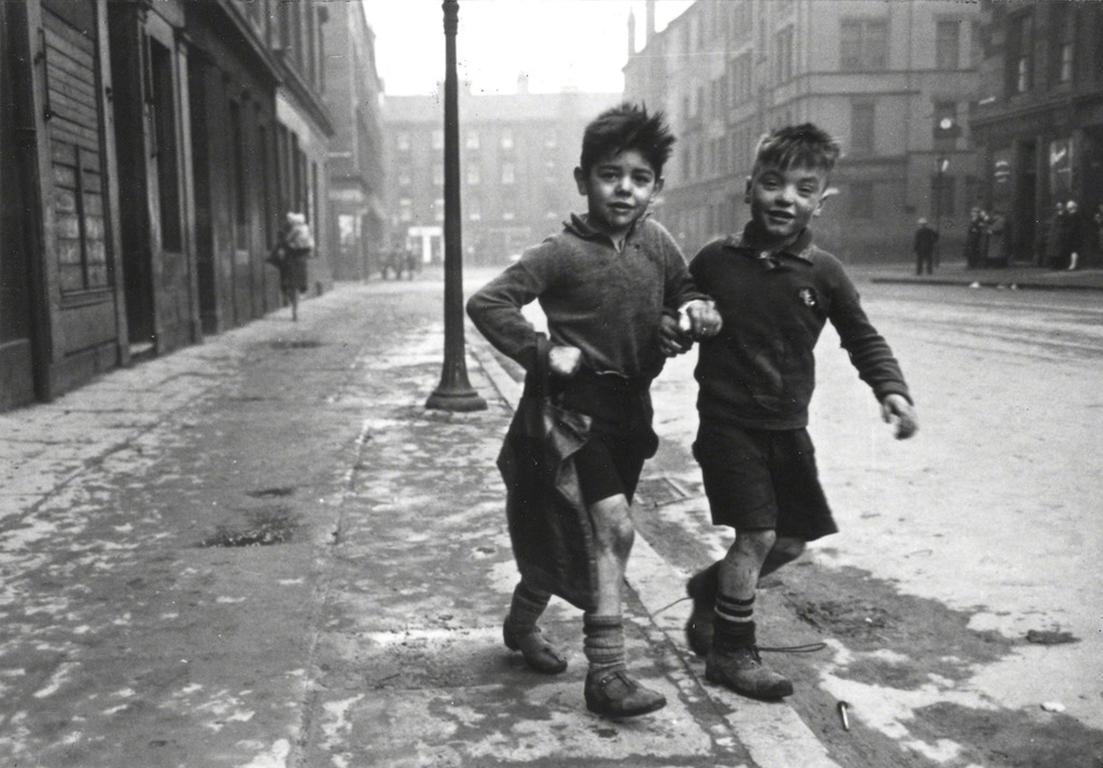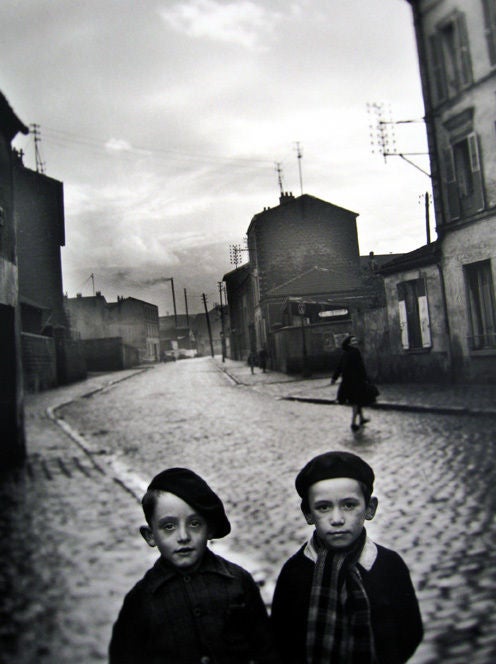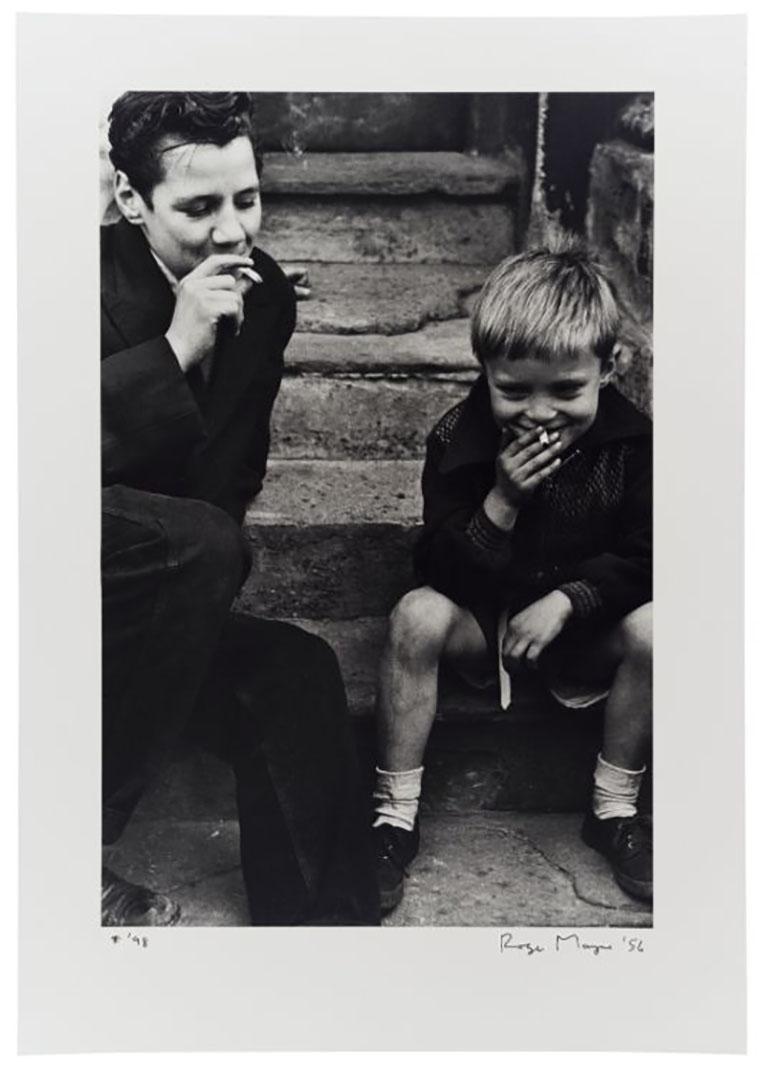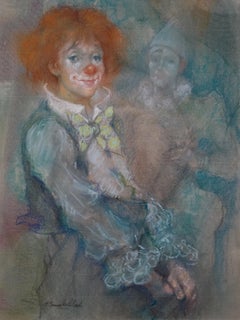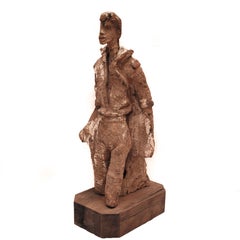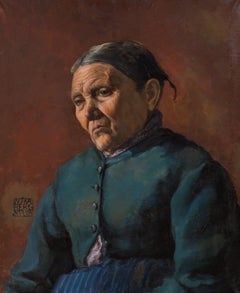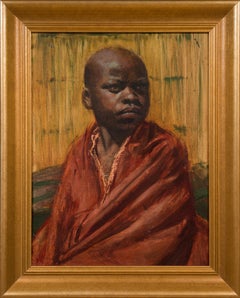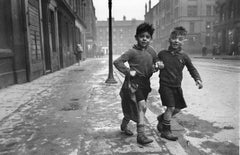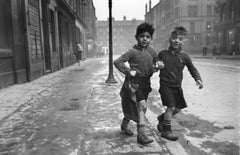Items Similar to The Boys, Montreuil – Paris 1962: Christer Strömholm’s Most Iconic Photograph
Want more images or videos?
Request additional images or videos from the seller
1 of 8
Christer StrömholmThe Boys, Montreuil – Paris 1962: Christer Strömholm’s Most Iconic Photograph2018
2018
$14,768.16
£11,069.65
€12,500
CA$20,288.94
A$22,650.69
CHF 11,868.62
MX$277,266.69
NOK 150,731.61
SEK 142,120.77
DKK 95,154.56
Shipping
Retrieving quote...The 1stDibs Promise:
Authenticity Guarantee,
Money-Back Guarantee,
24-Hour Cancellation
About the Item
Among Christer Strömholm’s most iconic images is Pojkarna, taken in the Paris suburb of Montreuil in 1962. Two small boys, one curious and leaning in, the other solemn and proud, meet the photographer’s gaze. Their scuffed faces, satchels in hand, and sturdy stance suggest a playful independence — but there is also a sense of quiet seriousness that gives the image its enduring psychological depth.
Strömholm, known for his intimate black-and-white portraits and pioneering street photography, had a remarkable sensitivity for portraying children. These portraits often reflect a sense of solitude and resilience, resonating with the artist’s own unsettled childhood. In Pojkarna, we see not just a moment of street life, but a universal image of childhood — raw, unsentimental, and deeply human.
The photograph has since become one of Strömholm’s most celebrated works, emblematic of his ability to capture fleeting moments with timeless intensity.
Pojkarna (The Boys), Montreuil, Paris, 1962
Stamp signed, photograph by Christer Strömholm Estate and numbered 5/50, edition 2016,
fine art print, printed in 2018, produced at Ilford Gallery RC paper ,
image area 34.5 x 24.5 cm, leaf size 49.5 x 39.5 cm.
frame included in the price.
About the Seller
5.0
Platinum Seller
Premium sellers with a 4.7+ rating and 24-hour response times
Established in 2020
1stDibs seller since 2020
189 sales on 1stDibs
Typical response time: <1 hour
Associations
International Confederation of Art and Antique Dealers' Associations
- ShippingRetrieving quote...Shipping from: Stockholm, Sweden
- Return Policy
Authenticity Guarantee
In the unlikely event there’s an issue with an item’s authenticity, contact us within 1 year for a full refund. DetailsMoney-Back Guarantee
If your item is not as described, is damaged in transit, or does not arrive, contact us within 7 days for a full refund. Details24-Hour Cancellation
You have a 24-hour grace period in which to reconsider your purchase, with no questions asked.Vetted Professional Sellers
Our world-class sellers must adhere to strict standards for service and quality, maintaining the integrity of our listings.Price-Match Guarantee
If you find that a seller listed the same item for a lower price elsewhere, we’ll match it.Trusted Global Delivery
Our best-in-class carrier network provides specialized shipping options worldwide, including custom delivery.More From This Seller
View AllThe Two Clowns (Les Deux Clowns) by Antonio Gonzalez Collado
By Antonio Gonzalez Collado
Located in Stockholm, SE
Artist: Antonio Gonzalez Collado
The Two Clowns (Les Deux Clowns)
mixed media on paper
signed
artist studio stamp on the back
dimensions (motif) 15...
Category
Late 20th Century Modern Portrait Drawings and Watercolors
Materials
Paper, Mixed Media
Large Terracotta Sculpture by Evert Lindfors, Sweden, 1970s
Located in Stockholm, SE
For sale: A captivating terracotta sculpture from the esteemed Swedish artist Evert Lindfors (1927-2016), crafted in the 1970s. A connoisseur of fine arts, Lindfors honed his craft at the prestigious École des Beaux-Arts in Paris during the 1940s. Best known for his vibrant paintings, he established his studio in the picturesque Provence region of Lacoste, France, in the mid-1950s. In a daring pivot late in the 1960s, Lindfors embraced the medium of terracotta sculpture. His path crossed with Torsten...
Category
1970s Modern Figurative Sculptures
Materials
Bronze
Rediscovered Mastery: A Portrait by Nina Bergstedt
Located in Stockholm, SE
This poignant portrait by Swedish artist Nina Bergstedt captures a quiet intensity that lingers in the viewer’s mind. The sitter, an unknown woman, is portrayed with deep emotional p...
Category
1890s Realist Portrait Paintings
Materials
Canvas, Oil
Portrait of a Young Boy in Red
Located in Stockholm, SE
Olle Hjortzberg (1872-1959) Sweden
Portrait of a Young Boy in Red
oil on board
signed with monogram OH
unframed 41 x 31.5 cm (16 1/8 x 12 3/8 in)
framed 51 x 41.5 cm (20 1/8 x 16 ...
Category
1930s Realist Portrait Paintings
Materials
Masonite, Oil
The Seated Man – An Intimate Glimpse into Daily Life
Located in Stockholm, SE
This masterfully executed painting by Emerik Stenberg (1873–1927) captures an intimate and atmospheric moment. The composition features a seated man, engrossed in his daily chores, b...
Category
Early 20th Century Realist Figurative Paintings
Materials
Canvas, Oil
Children by the Ice Hole by Swedish Artist Bengt Nordenberg, c. 1846
Located in Stockholm, SE
This evocative winter scene by Bengt Nordenberg captures a quiet moment of everyday life: two children stand on the frozen edge of a river or lake, watching as their mother washes cl...
Category
19th Century Figurative Paintings
Materials
Canvas, Oil
You May Also Like
'Gorbals Boys' Silver Gelatin Print (Limited Edition)
By Bert Hardy
Located in London, GB
'Blackpool Railings' Oversize Silver Gelatin Print (Limited Edition)
Now widely recognised as a Master of Photography - this is considered to be o...
Category
1950s Modern Black and White Photography
Materials
Silver Gelatin
Gorbals Boys (1948) - Silver Gelatin Fibre Print
By Bert Hardy
Located in London, GB
Gorbals Boys (1948) - Silver Gelatin Fibre Print
(Photo by Bert Hardy/Getty Images Archive London)
Possibly Bert Hardy's most famous image.
Two boys in the Gorbals area of Glasgow.
The Gorbals tenements were built quickly and cheaply in the 1840s, providing housing for Glasgow's burgeoning population of industrial workers.
Conditions were appalling; overcrowding was standard and sewage and water facilities inadequate.
The tenements housed about 40,000 people with up to eight family members sharing a single room,
30 residents sharing a toilet and 40 sharing a tap.
By the time this photograph was taken 850 tenements had been demolished since 1920.
Redevelopment of the area began in the late 1950s and the tenements were replaced with a modern tower block complex in the sixties. Original Publication: Picture Post - 4499 - The Forgotten Gorbals - pub. 1948
Additional Information:
Unframed
Paper Size: 20 x 16'' inches / 51 x 41 cm
Printed 2024
Silver Gelatin Fibre Print
Limited edition issued and stamped on front by the Getty Archive London
Edition size 300 only
NOTE OTHER SIZES OF THIS IMAGE AVAILABLE
10 x 8''
10 x 12''
12 x 16''
16 x 20''
20 x 24''
FRAMING AVAILABLE ON REQUEST
Bert Hardy Albert William Thomas Hardy (19 May 1913 – 3 July 1995)
was an English documentary and press photographer
known for his work published in the Picture Post magazine between 1941 and 1957.
Life and work Born in Blackfriars, Bert Hardy rose from humble working class origins in Southwark, London.
The eldest of seven children, he left school at age 14 to work for a chemist who also processed photos.
His first big sale came in 1936 when he photographed King George V and Queen Mary in a passing carriage during the Silver Jubilee celebrations, and sold 200 small prints of his best view of the King.
His first assignment, at age 23, was to photograph Hungarian actor Sakall at the Mayfair Hotel.
Hardy freelanced for The Bicycle magazine, and bought his first small-format 35 mm Leica.
He signed on with the General Photographic Agency as a Leica photographer,
later founding his own freelance firm, Criterion.
General Photographic Agency General Photographic Agency a Fleet Street, London agency, sold photos at least between 1880-1950.
Picture Post and World War II In 1941,
Hardy was recruited by the then editor Tom Hopkinson of the leading picture publication of the 1930s to the 1950s, Picture Post.
Founded in 1938 and funded by publisher Edward Hulton, the magazine's first editor was Hungarian émigré Stefan Lorant (1901–97) assisted by Hopkinson, who took over as editor from 1940. The picture-centric, left-leaning and reasonably-priced publication was highly successful and circulation soon rose to over a million.
Hardy's photographer colleagues included Felix H. Man (aka Hans Baumann...
Category
1940s Modern Figurative Photography
Materials
Black and White, Silver Gelatin
'Gorbals Boys' Bert Hardy Limited Edition Silver Gelatin Fibre Print
By Bert Hardy
Located in London, GB
'Gorbals Boys' (1948)
by Bert Hardy
Limited Edition 44/300
Silver Gelatin Fibre Print
Paper size 10 x 12 inches
Printed later
Two boys in the Gorbals area of Glasgow. The Gorbal...
Category
Mid-20th Century Realist Black and White Photography
Materials
Silver Gelatin
The Gorbals Boys, Glasgow - Bert Hardy (Black and White Photography)
By Bert Hardy
Located in London, GB
The Gorbals Boys, Glasgow - Bert Hardy (Black and White Photography)
Signed on front, stamped with photographer's copyright ink stamp on reverse
Silver gelatin print, printed later
1...
Category
1940s Black and White Photography
Materials
Silver Gelatin
Aubervilliers
By Louis Stettner
Located in Santa Monica, CA
signed by artist
Category
1950s Photography
Materials
Silver Gelatin
Price Upon Request
Boys Smoking, Southam St, N. Kensington, 1956 - Roger Mayne (Black and White)
By Roger Mayne
Located in London, GB
Signed and dated
Signed, titled and dated on reverse
Silver gelatin print, printed 1998
10 1/2 x 9 inches
Roger Mayne (1929-2014) is a British photographer known for his series documenting the children of Southam Street, West London. Influenced as much by the St Ives school of artists as by his photographer contemporaries, Mayne consciously printed with high contrast to emphasise the formal qualities of his work and increased the scale of his prints to pursue a dialogue with contemporary painting.
The images which Roger Mayne captured between 1956 and 1961 at Southam Street, London represent the most significant personal and professional project of his career. At that time, Southam Street in North Kensington had changed little since Victorian times and was later declared uninhabitable, making way for Erno...
Category
Mid-20th Century Photography
Materials
Silver Gelatin
More Ways To Browse
Christ Icon
Christer Stromholm
Arnold Singer
Helmut Newton Gelatin Print
James Gibson
Andy Warhol Jon Gould
Black Panther Light
Drew Doggett Sailing
Jon Gould
Kurt Vonnegut Prints
Tango Photography
Vintage Cyanotypes
Alessandra Ambrosio
Jackie Curtis
Joan Didion Photography
John Coltrane
Johnny Cash Art
Sexy Vintage Nudes
